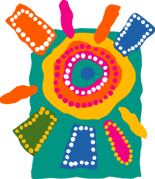
|

Contemporary Indigenous art is extremely diverse. In addition to regional differences the complexity of colonisation has resulted in a variety of historical experiences for Aboriginal people, which is reflected in their art.
Diversity and difference
There is no single homogenous Aboriginal people or community. However there are distinctions that can be drawn on the basis of "history, politics, culture and demography" (Langton 1993, 11).
The approach adopted by many writers recognises two main regions:
|
|

Key concepts |
• traditional art
• contemporary art
|
|
|
| |
- 'settled' Australia where the majority of Aboriginal people reside in capital cities and small rural towns - in this region the colonial frontier moved swiftly and surely and Aboriginal people suffered dispossession from their land and great destruction of their cultural heritage;
- the north of the continent - in this region colonisation was delayed allowing Aboriginal communities the opportunity to maintain more of their traditional hunter-gatherer lifestyle.
|
|
|
 |
Read pp. 4-10 |
|
Categorising Aboriginal art
Morphy argues against the division of Aboriginal art into categories of 'tribal' and 'urban', 'classical' and 'modern', 'traditional' and 'non-traditional'. He thinks that these categories do not reflect the reality of Aboriginal people's lives and they create more problems than they solve. For example:
Aboriginal people from Arnhem Land have been influenced by the presence of urban Darwin and many have lived there on and off since the township was established, even though they may have retained their own distinctive languages and practices (Morphy, 1998, 7). |
|
|

Have a look at some 'urban' artists showing in city galleries. Many of these Aboriginal artists interrogate the idea of Aboriginality in their work:
Gordon Bennett
View the Notes to Basquiat exhibition.
Tracey Moffatt
See a selection of Moffatt's photographic exhibitions.
Read the story behind the photo series: Fourth.
Fiona Foley
Wild Times Call: images
Wild Times Call: commentary
Destiny Deacon
See a variety of Deacon's exhibitions.
Read about d-tour.
These organisations represent Aboriginal artists in Northern Australia:
Desart Inc
Visit some of the many Art Centres of the Assoc. of Aboriginal Art & Craft Centres of Central Australia e.g. Papunya Tula, Hermannsburg Potters, and Tjanpi weaving.
ANKAA
Links you to Aboriginal owned and operated Art Centres' websites in the Top End of the Northern Territory and north of Western Australia.
Northern Editions
Located at CDU, displays and sells Indigenous art. View their online gallery.
What is terra nullius?
|
|
| |
What is tradition and why is it important? |
|
Tradition is often seen as the benchmark of an authentic Aboriginality. However this mistakenly assumes that traditions are static and unchanging, passed down intact from one generation to another. When traditions change, Indigenous people and their art are taken to be inauthentic. In reality, traditions are always in flux. |
|
| |
How do we define contemporary Australian Indigenous art? |
|
Contemporary Australian Indigenous art refers to the art of Aboriginal and Torres Strait Islander people. It takes into account:
- regional styles;
- historical experiences; and
- the range of work by individual artists.
Contemporary Aboriginal art is an expression of cultural pride and identity. The Aboriginal Flag designed by Luritja artist Harold Thomas in 1971, is a potent symbol of Aboriginality (see Morphy , Illustrations 265, 279).
Until recently the distinctive identity of Torres Straits Islanders was subsumed within the broader category of Aboriginal Australia. However the Torres Strait Islands came to national prominence in 1991 with the successful land rights case mounted by Murray Islander Eddie Mabo which overturned the doctrine of terra nullius for all Indigenous Australians. The flag of the Torres Strait Islanders, designed by Bernard Namok, was adopted the following year.
The distinctive style of Torres Strait Islander art is reflected in the work of Ellen Jose's installation (Morphy, Illustration 227) and Ken Thaiday's dance machine (Morphy, Illustration 225). |
|
 | Maughan: Polemic ...
Janet Maughan discusses the changing historical perceptions toward Australian Indigenous art. The 'paradigmatic shift' that occurred in the 1960s and 1970s saw the emergence of an Aboriginal 'voice', policies of self-determination and the land rights movement. |
|
 |
Langton: Homeland ...
Maughan sees contemporary Indigenous art as equivalent to Australian art. Marcia Langton goes further. She maintains that contemporary Indigenous art should be viewed and understood within the 'global canon of world art'. |
|
|
|
Looking at Aboriginal art
Using Morphy's Index, make notes about each of the following artists and their work.
Mundargg (Mandarrk),
Spirit with Wallaby and Honey -collecting Bags, 1979.
Cover Illustration (and Illustration 118).
Robert Campbell Jnr, Aboriginal Embassy, 1986. (Morphy, Illustration 1).
In 1972 Aborigines put up a tent embassy in front of Parliament House in Canberra. This painting commemorates the event.
What different historical experiences have Mundargg and Robert Campbell Jnr had?
How are these experiences reflected in the style and content of their artwork?
|
|
|
| |
 |
 |
|
 |